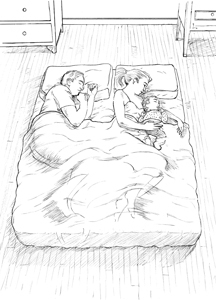How To Get Your Baby To Sleep Without Being Held
Safe Cosleeping Guidelines
Guidelines to Sleeping Safe with Infants:
Adapted from: Maximizing the chances of Safe Infant Sleep in the Solitary and Cosleeping (Specifically, Bed-sharing) Contexts, by James J. McKenna, Ph.D. Professor of Biological Anthropology, Director, Mother-Baby Sleep Laboratory, University of Notre Dame.
Below is a summary that highlights some of the issues to be concerned with as you make your own decisions about where and how your infant should sleep.

What constitutes a "safe sleep environment" irrespective of where the infant sleeps?
Safe infant sleep ultimately begins with a healthy gestation. Specifically, safe infant sleep begins without the fetus being exposed to maternal smoke during pregnancy.
A second factor that has a strong influence on safe infant sleep is breastfeeding. Breastfeeding significantly helps to protect infants from death including deaths from SIDS/SUDI and from secondary disease and/or congenital conditions. Post-natally safe infant sleep begins especially with the presence of an informed, breastfeeding, committed mother, or an informed and committed father.
Regardless of whether an infant sleeps on the same surface as his or her parents, on a same-surface co-sleeper, in a bassinet or in a separate crib, in the same room as their parents or in a separate room, all infants should follow these same guidelines: infants should always sleep on their backs, on firm surfaces, on clean surfaces, in the absence of (secondhand) smoke, under light (comfortable) blanketing, and their heads should never be covered.
The bed should not have any stuffed animals or pillows around the infant and never should an infant be placed to sleep on top of a pillow or otherwise soft bedding.
Sheepskins or other fluffy material and especially beanbag mattresses should never be used with infants. Waterbeds can be especially dangerous to infants too, and no matter the type of mattress, it should always tightly intersect the bed-frame to leave no gaps or space. Infants should never sleep on couches or sofas with or without adults as they can slip down (face first) into the crevice or get wedged against the back of a couch where they may suffocate.
Bedsharing: It is important to be aware that adult beds were not designed to assure infants safety!
- It is important to realize that the physical and social conditions under which infant-parent cosleeping occur, in all it's diverse forms, can and will determine the risks or benefits of this behavior. What goes on in bed is what matters.
- Bottlefeeding babies should always sleep alongside the mother on a separate surface rather than in the bed.
- If bedsharing, ideally, both parents should agree and feel comfortable with the decision. Each bed-sharer should agree that he or she is equally responsible for the infant and acknowledge before sleeping that they are aware that the infant is present in the bed space. Do not place an infant in the bed with a sleeping adult who is not aware that the infant is in the bed with them. My feeling is that both parents should think of themselves as primary caregivers.
- Infants a year or less should not sleep with other/older child siblings -- but always with a person who can take responsibility for the infant being in the bed.
- Persons taking sedatives, medications or drugs, or intoxicated from alcohol or other substances, or otherwise excessively unable to arouse easily from sleep should not cosleep on the same surface with the infant.
- Excessively long hair on the mother should be tied up to prevent infant entanglement around the infant's neck (yes, this has very unfortunately happened).
- Extremely obese persons or others who may have difficulty feeling where exactly or how close their infant is in relation to their own body, may wish to have the infant sleep alongside but on a different surface, such as a cosleeper attachment.
- Finally, it may be important to consider or reflect on whether you would think that you suffocated your baby if, under the most unlikely scenario, your baby died from SIDS while in your bed. Just as babies can die from SIDS in a risk-free solitary sleep environment, it remains possible for a baby to die in a risk-free cosleeping/bedsharing environment. Just make sure, as much as this is possible, that you would not assume that if the baby died, that either you or your spouse would think that bed-sharing contributed to the death, or that one of your really suffocated (by accident) the infant. While this is an unpleasant and uncomfortable topic, it is one that is worth thinking about before you make the choice to cosleep/bedshare with your infant.
Aside from never letting an infant sleep outside the presence of a committed adult, i.e. separate-surface cosleeping which is safe for all infants, I do not recommend to any parents any particular type of sleeping arrangement since I do not know the circumstances within which particular parents live. What I do recommend is to consider all of the possible choices and to become as informed as is possible matching what you learn with what you think can work the best for you and your family.
How To Get Your Baby To Sleep Without Being Held
Source: https://cosleeping.nd.edu/safe-co-sleeping-guidelines/
Posted by: johnsonthearle.blogspot.com

0 Response to "How To Get Your Baby To Sleep Without Being Held"
Post a Comment